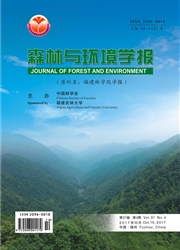

 中文摘要:
中文摘要:
采用单因子随机区组设计,以当年生千年桐幼苗为材料,设置5种育苗密度D1(10 cm× 10 cm)、D2(15 cm×15 cm)、D3(20 cm ×20 cm)、D4(25 cm ×25cm)和D5(30 cm×30 cm),研究不同育苗密度对千年桐幼苗叶片的叶绿素荧光特性和高径比的影响.结果表明:不同育苗密度间千年桐幼苗叶片的叶绿素荧光参数的变化规律有差异,不同月份间也存在差异;9月份,D1对千年桐幼苗的生长较有利,D5次之;10月份,光化学淬灭系数(qP)随育苗密度增大而增大,高径比随育苗密度减小而减小,其中D5的PSⅡ实际光化学效率(Yield)、电子传递的相对速率(ETR)、PSⅡ最大化学效率(Ft/Fm)和PSⅡ潜在光化学活性(Fv/Fo)均为最高,非光化学猝灭系数(qN)最低,D5最有利千年桐幼苗生长.综合2个月的叶绿素荧光参数和高径比,认为D5是千年桐幼苗生长的最适育苗密度.
 英文摘要:
英文摘要:
In this study, five planting densities of Aleurites montana seedlings were set up as D1 (10 cm × 10 cm), D2 (15 cm×15 cm) , D3 (20 cm ×20 cm), D4 (25 cm ×25 cm) and 1)5 (30 cm ×30 cm) by single factor randomized block design. After five and six months' growth, the effects of different planting densities on the characteristics of cMorophyU fluorescence and ratio of height to diameter were compared. The results showed that the chlorophyll fluorescence of A. montana seedlings varied intricately between different planting densities, and the variations were different between months. In September, D1 was the optimal density for seedling growth, followed by DS. In October, photochemical quenching coefficient (qP) increased under the higher seedling densities and the ratio of height to diameter decreased under the lower densities, quantum yield of PSl] electron transport (Yield) was the highest, electron transport rat (ETR), maximum photochemical efficiency (Fv/F~) and potential photochemical efficiency (F,/Fo) were also the highest, non-photochemical quenching (qP), however, was the lowest, comprehensively D5 was the most favorable for seedling growth. Taking chlorophyll fluorescences and ratio of height to diameter in September and October into consideration, the seedling density in D5 was the most suitable for A. montana seedling growth.
 同期刊论文项目
同期刊论文项目
 同项目期刊论文
同项目期刊论文
 期刊信息
期刊信息
